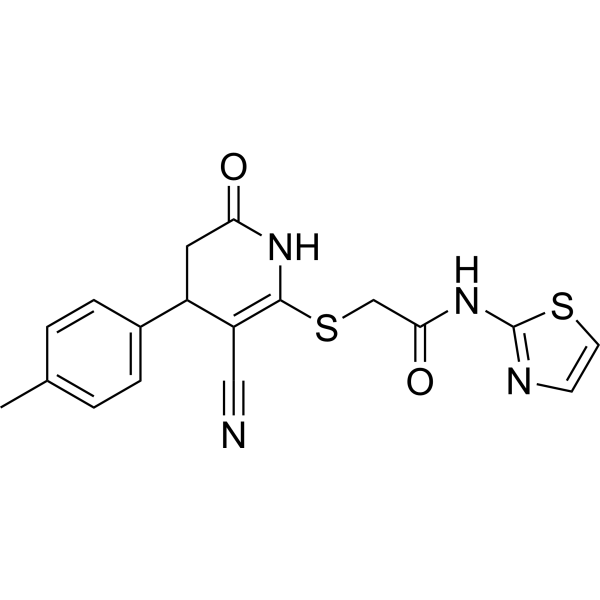Physicochemical Properties
| Molecular Formula | C18H16N4O2S2 |
| Molecular Weight | 384.48 |
| Exact Mass | 384.071 |
| CAS # | 375835-43-1 |
| PubChem CID | 3841655 |
| Appearance | Off-white to light yellow solid powder |
| Density | 1.4±0.1 g/cm3 |
| Index of Refraction | 1.675 |
| LogP | 0.968 |
| Hydrogen Bond Donor Count | 2 |
| Hydrogen Bond Acceptor Count | 6 |
| Rotatable Bond Count | 5 |
| Heavy Atom Count | 26 |
| Complexity | 634 |
| Defined Atom Stereocenter Count | 0 |
| InChi Key | LOQIRQHGJVGIEL-UHFFFAOYSA-N |
| InChi Code | InChI=1S/C18H16N4O2S2/c1-11-2-4-12(5-3-11)13-8-15(23)21-17(14(13)9-19)26-10-16(24)22-18-20-6-7-25-18/h2-7,13H,8,10H2,1H3,(H,21,23)(H,20,22,24) |
| Chemical Name | 2-[[5-cyano-4-(4-methylphenyl)-2-oxo-3,4-dihydro-1H-pyridin-6-yl]sulfanyl]-N-(1,3-thiazol-2-yl)acetamide |
| HS Tariff Code | 2934.99.9001 |
| Storage |
Powder-20°C 3 years 4°C 2 years In solvent -80°C 6 months -20°C 1 month Note: This product requires protection from light (avoid light exposure) during transportation and storage. |
| Shipping Condition | Room temperature (This product is stable at ambient temperature for a few days during ordinary shipping and time spent in Customs) |
Biological Activity
| Targets | RIPK1 |
| ln Vitro | Necrostatin-34 (Nec-34) in FADD def-Jurkat cells and L939 cells had IC50 values for TNFα of 667 nM and 134 nM, respectively[1]. The phosphorylation of RIPK1's Ser166 (p-S166), a biomarker for RIPK1 activation, indicates that necrostatin-34 (Nec-34, 10 μM) suppresses the dimerization-induced RIPK1 activation[1]. Necrostatin-34 (Nec-34) has the potential to prevent TNFα-induced complex II formation by impeding RIPK1 kinase activation[1]. |
| Cell Assay |
Western Blot Analysis[1] Cell Types: RIPK1 knockout L929 cells transfected with an expressing vector encoding an inducible and dimerizable RIPK1 fused with FKBP at the C-terminus. Tested Concentrations: 10 μM. Incubation Duration: 30 min (and then 100 ng/mL TNFα was added for indicated periods of time). Experimental Results: Downregulated p-S166 levels. |
| References |
[1]. Discovery of a cooperative mode of inhibiting RIPK1 kinase. Cell Discov. 2021 Jun 1;7(1):41. |
Solubility Data
| Solubility (In Vitro) | DMSO : 125 mg/mL (325.11 mM) |
| Solubility (In Vivo) |
Solubility in Formulation 1: ≥ 2.08 mg/mL (5.41 mM) (saturation unknown) in 10% DMSO + 40% PEG300 + 5% Tween80 + 45% Saline (add these co-solvents sequentially from left to right, and one by one), clear solution. For example, if 1 mL of working solution is to be prepared, you can add 100 μL of 20.8 mg/mL clear DMSO stock solution to 400 μL PEG300 and mix evenly; then add 50 μL Tween-80 to the above solution and mix evenly; then add 450 μL normal saline to adjust the volume to 1 mL. Preparation of saline: Dissolve 0.9 g of sodium chloride in 100 mL ddH₂ O to obtain a clear solution. Solubility in Formulation 2: ≥ 2.08 mg/mL (5.41 mM) (saturation unknown) in 10% DMSO + 90% Corn Oil (add these co-solvents sequentially from left to right, and one by one), clear solution. For example, if 1 mL of working solution is to be prepared, you can add 100 μL of 20.8 mg/mL clear DMSO stock solution to 900 μL of corn oil and mix evenly. (Please use freshly prepared in vivo formulations for optimal results.) |
| Preparing Stock Solutions | 1 mg | 5 mg | 10 mg | |
| 1 mM | 2.6009 mL | 13.0046 mL | 26.0092 mL | |
| 5 mM | 0.5202 mL | 2.6009 mL | 5.2018 mL | |
| 10 mM | 0.2601 mL | 1.3005 mL | 2.6009 mL |
